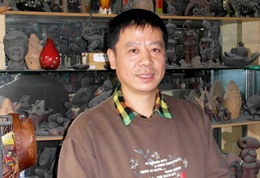About Song Wei and His Products
Ocarinas vary.... from maker to maker, model to model, even from note to note. People vary too. So, when person meets ocarina, the interactions multiply. Put another way, making the "perfect" ocarina to suit everyone is likely an unrealistic goal. What we'd like to do in this section is help you, as best we can, to understand the characteristics of the ICO Bulls. Making informed purchase decisions is just plain good sense.
Purple Clay
All of Song Wei's ocarinas and xun are made from purple clay 紫砂 (literally, purple sand), also known as Yixing clay because it is mined near the city of Yixing in Jiangsu Province. Purple clay is significantly more porous than many other types of clay, including the porcelain clays used to make most ocarinas, being higher in sand content. Purple clay's porosity makes it well suited for the making of teapots.
Song Wei prefers purple clay because of the more resonant and mellow sound it produces in an ocarina. His early career background as a porcelain artist led him initially to make ocarinas from porcelin clay but he soon discovered the difference in sound quality and switched exclusively to purple clay. We recognize that there is still some debate about whether material per se influences sound quality of an ocarina. Actually, this debate goes well beyond ocarinas into various woodwind and even brass instruments. See, for instance, the following articles: Article 1 Article 2. Scientific research in general tends to conclude that material makes little to no difference, while musicians mostly remain adamant that they can hear significant differences due to material! We observe, however, that no studies of this kind have specifically tested different clay types and ocarinas. The fact that different metals and plastics may make no difference in sound resonance in flutes, recorders, and trumpets does not necessarily settle the question for purple clay and ocarinas. Song Wei's experience of making ocarinas the same way with both porcelin vs. purple clay is our primary reason for feeling that purple clay produces a more mellow sound.
There may come a day when we will all know for sure whether it's the purple clay or the way the ocarina maker shapes the voicing that primarily affects sound quality. In the meantime, I suggest we just enjoy the warm and mellow sound of an ICO purple clay ocarina!
Post-Firing Process
After Song Wei has put his design magic into an ocarina and it has come out of the kiln, there’s still much to do.
Initial quality inspection. All ICO ocarinas must pass inspection on all aspects affecting playing quality. If an ocarina doesn’t meet these standards, then it simply is not accepted into ICO inventory. If a custom order turns out substandard in any aspect, then another custom piece is made.
Our first step is to check the lowest notes of the ocarina (or first chamber of a multi-chamber ocarina) for breath pressure requirement. Our target is to produce instruments with a comfortable medium-level breath pressure at the low notes. Thus, for instance, an alto C ocarina that plays excessively quietly and with a low breath pressure requirement to play C5 concert pitch will be rejected. In fact, we insist that the low notes played by the subholes (e.g., B4, A#4, and A4 on an alto C ocarina) must also produce reasonably strong sound. These 3 lowest notes naturally require the lowest breath pressure for the ocarina. However, the breath pressure required to play these 3 notes on many ocarina brands is so vanishingly low that they are difficult to play and can scarcely be heard, often rendering these notes all but useless in playing music.
Next, the ocarina is checked for squeaking and other off sounds. If the ocarina squeaks at a breath pressure close to the breath pressure required to play in tune for that note, small modifications to the voicing area (by a skilled hand!) can often correct the problem. Squeaking is only tolerated when it occurs at a breath pressure significantly above (or below) the in-tune breath pressure. In other words, each note must have a fairly wide margin of squeak free playability at breath pressures on either side of proper pitch, leaving plenty of room for vibrato and the low levels of over- or under-blowing that may occur during normal playing. Similarly, ocarinas with significant airiness (typically in the top note of a chamber) are also rejected at this stage, as are multi-chamber ocarinas with noticeably different sound quality between chambers.
Tuning. Clay shrinks during firing and not necessarily evenly between batches of clay. Thus, post-firing tuning is essential, and is done by adjusting tonehole size. Our goal is to tune for a slight increase in breath pressure requirement as one moves up the scale beginning with the tonic (i.e., the tonic is C for a C ocarina). Upon reaching the second chamber, the breath slope generally declines to near zero, such that breath requirement only barely increases as one moves through the upper chambers of an ICO multi-chamber ocarina. A nearly flat breath pressure rise across the second and higher chambers prevents the ocarina from getting too loud and breathy in these higher chambers. Describing this from another point of view, we could say that the breath pressure at the top end of the first chamber is sufficient to provide a comfortable breath pressure and loudness for the higher chambers of the ocarina.
For multi-chamber ocarinas, inter-chamber tuning balance becomes important. The first and second chamber share a note in common… for instance, in a C double chamber ocarina, the D#/E can be played as the top note of the first chamber (all holes uncovered) and the bottom note of the second chamber (all holes covered including subhole). Our tuning ensures that the D#/E
can be played as the top note of the first chamber (all holes uncovered) and the bottom note of the second chamber (all holes covered including subhole). Our tuning ensures that the D#/E played on the second chamber requires the same breath pressure as the D#/E
played on the second chamber requires the same breath pressure as the D#/E played on the first chamber, modifying the second chamber tuning hole size as needed to bring those two notes into congruence. Then we match breath pressure requirements between the D of the first chamber and the E of the second chamber, modifying the second chamber subhole size as needed. A similar inter-chamber tuning balance process goes on as one moves to the third and fourth chambers of a triple or quad, thus ensuring a smooth breath slope through the entire range of the instrument.
played on the first chamber, modifying the second chamber tuning hole size as needed to bring those two notes into congruence. Then we match breath pressure requirements between the D of the first chamber and the E of the second chamber, modifying the second chamber subhole size as needed. A similar inter-chamber tuning balance process goes on as one moves to the third and fourth chambers of a triple or quad, thus ensuring a smooth breath slope through the entire range of the instrument.
 can be played as the top note of the first chamber (all holes uncovered) and the bottom note of the second chamber (all holes covered including subhole). Our tuning ensures that the D#/E
can be played as the top note of the first chamber (all holes uncovered) and the bottom note of the second chamber (all holes covered including subhole). Our tuning ensures that the D#/E played on the second chamber requires the same breath pressure as the D#/E
played on the second chamber requires the same breath pressure as the D#/E played on the first chamber, modifying the second chamber tuning hole size as needed to bring those two notes into congruence. Then we match breath pressure requirements between the D of the first chamber and the E of the second chamber, modifying the second chamber subhole size as needed. A similar inter-chamber tuning balance process goes on as one moves to the third and fourth chambers of a triple or quad, thus ensuring a smooth breath slope through the entire range of the instrument.
played on the first chamber, modifying the second chamber tuning hole size as needed to bring those two notes into congruence. Then we match breath pressure requirements between the D of the first chamber and the E of the second chamber, modifying the second chamber subhole size as needed. A similar inter-chamber tuning balance process goes on as one moves to the third and fourth chambers of a triple or quad, thus ensuring a smooth breath slope through the entire range of the instrument.Surface Finishing. As of September 15, 2020, ICO has adopted a textured application of epoxy resin varnish. This water-soluble varnish is odorless, highly durable, and provides high moisture resistance as well as being safe for the user, and texturing gives an attractive appearance to the finish. For 3 to 4 years before September 2020, our standard treatment included a complete sanding of the ocarina surface to remove large scratches and other irregularities, to round off edges (including tonehole edges), and to reveal the underlying grainy look of the purple clay. After a thorough washing to remove all dust, the surface was sealed with a food safe varnish. Finally, the mouthpiece area was treated with two coats of epoxy varnish which not only provided further protection for the mouthpiece area but also made the mouthpiece area easier to clean as well as improving ease of chamber switching for multi-chamber models.
Below are a couple of photographs showing the appearance of our current textured epoxy finish. This finish is not reflected in the photos displayed on each product page, so the pictures below must serve that purpose for all currently purchased ICO ocarinas.
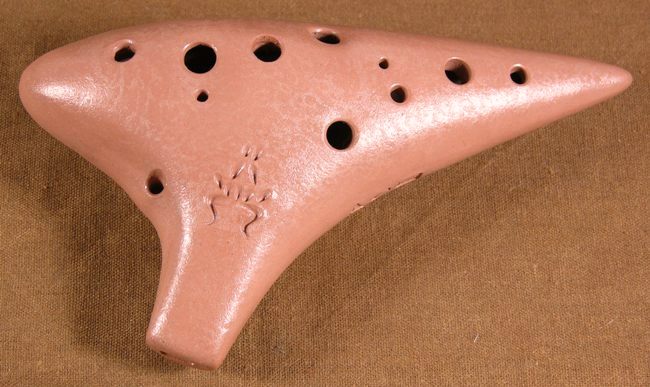
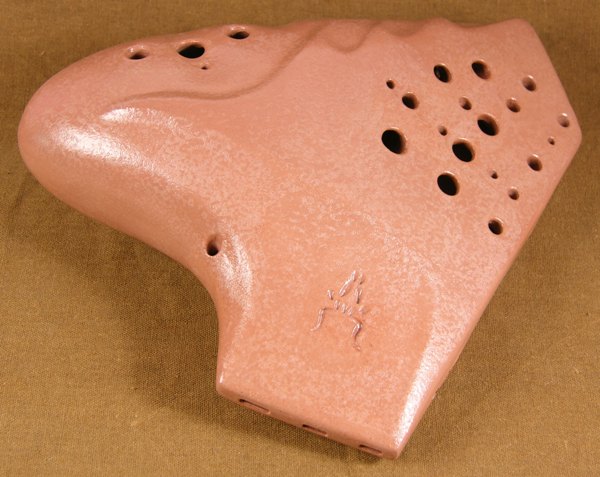
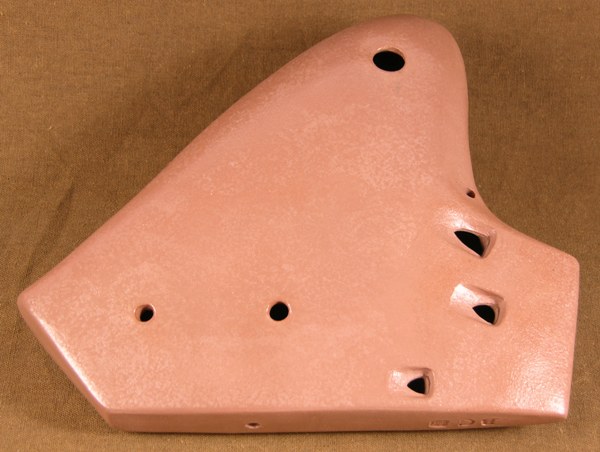
Technical and Performance Aspects
Breath pressure and slope. Breath pressure describes how hard or softly the ocarina must be blown to achieve proper pitch. Breath slope expresses the change from note to note in breath requirement as one moves up or down the scale.
ICO Bulls are designed as medium breath instruments. Especially important to us is avoiding a low breath requirement on the lowest notes of the instrument. For instance, given a 12-hole alto ocarina in C or the first chamber of a multi-chamber alto ocarina in C, even many medium breath ocarina brands will play excessively quiet and low breath on the low C (C5), with even lower breath demanded when covering subholes to get down to the B4 and A4. At ICO, we want those lowest notes to play with a comfortable breath pressure and to produce a reasonable sound volume. The starting breath pressure on ICO bass ocarinas is essentially the same as that of the altos. The contrabass ocarina, however, due to the physics of such an instrument, does have a low breath requirement and a quiet sound volume on the low end of its range.
The breath requirement of ICO ocarinas increases slightly with each note as one moves upward within the first chamber, thus producing a slight or shallow breath slope. With our multi-chamber ocarinas, upon reaching the 2nd chamber, note-to-note breath pressure rise is slight to none.
A poorly made ocarina may squeak even when played at proper breath pressure. Over-blowing (or under-blowing) an ocarina can also produce squeaking. The important question then becomes... how hard do I need to over-blow this ocarina to get a squeak? If the squeak threshold lies too close to the breath pressure needed for proper concert pitch, unwanted squeaking may still occur on occasion during normal playing. ICO Bulls are screened with extra care in this regard. Ocarinas that squeak too close to proper breath pressure simply don’t make it into ICO’s inventory.
Balance. This describes, in multi-chamber ocarinas, the degree of noticeable sound quality differences between chambers as well as the degree of breath pressure change when switching from chamber to chamber. A perfectly balanced multi-chamber produces sounds of virtually identical quality across chambers without leaving the impression that notes from different chambers are notes from entirely different ocarinas. As you listen to video sound clips provided on this website, especially the scale runs, we think you'll agree that our ICO Bulls have good to excellent balance. Ocarinas that don't meet this specification are culled. Yet, to Song Wei's credit as an ocarina maker, such culls are actually rare.
ICO ocarinas are also tuned so that breath pressure requirement matches at the juncture between chambers (see more details above). For instance, on a C double chamber ocarina, when playing from the E on the 2nd chamber down to the D on the 1st chamber, the breath pressure transition feels seemless, not requiring the ocarinist to suddenly change breath pressure during a chamber switch. See additional comments in the above section.
Moisture accumulation. First, the theory. Depending on windway design, material from which the ocarina is constructed, and the ocarinist, moisture can sometimes accumulate in the windway to the point that playing is affected. Plastic ocarinas can be especially prone to this problem, since plastic is completely non-absorptive. Playing in cold environments can also trigger condensation and consequent excess accumulation in the windway. Actually, one of the most significant causes of windway moisture build-up, in ocarinas prone to this problem, is the volume of moisture produced by the ocarinist! This problem usually self-corrects with practice.
We have not experienced windway moisture problems with the ICO Bulls and don't expect to. The porosity of purple clay provides an extra hedge against windway accumulation since a portion of excess moisture is absorbed by the clay, thus reducing the amount of free moisture available to create windway blockage.
Why Are Imperial City Ocarinas So Inexpensive?
People often wonder how ICO can offer purple clay ocarinas at such low prices, especially in the multi-chamber category. It's a reasonable question...
First of all, we’re less expensive due to lack of a glaze finish. Glazing purple clay is challenging. The kiln temperature requirements for many glazes are not compatible with temperatures suitable for firing purple clay. Food-safe glazes having temperature compatibility with purple clay are difficult to find. In any case, offering a non-glazed product reduces our costs and we pass those savings along to our customers. As to the appearance, Song Wei likes the look of purple clay with a simple transparent varnish finish and finds that a number of ocarina enthusiasts do too.
A second reason for our low pricing is low production overhead. Song Wei produces ocarinas in his home. Everything needed is in there, including an electronically controlled kiln. Lower overhead costs would be difficult to imagine. In addition, ICO is located in northeast China where costs for both living and manufacturing are significantly lower than in south China and much lower than in Taiwan or Korea. Thus, we are better able to pass along great pricing to customers.
Finally, ICO sells ocarinas without the extras often offered by the large ocarina companies. Extras like fancy packaging, a fine storage box, music books, printed fingering charts and the like are not something we provide along with your purchase. Padded cases and neckcords are provided for all of our ocarina models. But basically, our decision to provide just the ocarina product is yet another factor helping us to keep pricing low.
But don't let our low pricing leave you with the wrong impression! While minimizing production costs, we cut no corners when it comes to quality of the ocarinas themselves. Song Wei makes ocarinas one at a time. Temperature is carefully controlled during firing. A final inspection makes sure that all aspects affecting musical quality (pitch, tonal quality, chamber balance, airiness or other off-sounds, etc.) are up to standards. See above if you've not read about our quality control process. Those ocarinas not meeting our quality specifications are culled from ICO inventory. And Song Wei stands behind his ocarinas with a solid returns policy.
Yes, we've thought about raising prices of our multi-chambers, simply to project an image of higher quality. Yet, one of our goals as a company is to make high quality ocarinas, especially multi-chambers, affordable to a much greater number of players.
We invite you to compare ICO's quality with any of your favorite brands. Run both through the note range, side by side. Then when you discover for yourself that ICO meets or exceeds the quality of that name brand, you'll be in a better position to ask yourself whether spending multiple times the money makes good sense!
A Frequent Customer Request...
Often customers will request that we send them the ocarina with the best chamber balance or the best sound quality or the best something. The idea seems to be that we have a pile of mass produced ocarinas in front of us, all varying in quality aspects, with some excellent, some good, and some not so good. If you've been reading the above, by now you know that it's not like that at ICO. We simply don't take the good and the not so good! So, if you ask for the best, we will certainly comply with your request... it's just that you needn't have asked!
Personal History
Song Wei was born in northeast China in 1967. He began his career as a ceramics artist in 1983 at the Shenyang Ceramics Institute, developing a wide variety of both porcelin and purple clay pieces. He has displayed his work at pottery conventions in Beijing and has been featured on programming run on the National, Liaoning Provincial, and Shenyang Television Stations. Song Wei has also participated in a variety of other artistic conventions and other activities across China. He is currently a member of the Liaoning Province Artists' Society and the Shenyang Artists' Society.
In 1998, Song Wei broadened his clay artistry work to include ocarinas, xun, and the mankou xun. By 2007, he was making these clay instruments full time. Song Wei makes ocarinas of many different shapes and sizes, from small pendants to 12-hole sweet potato style ocarinas, to double and triple chambers, all the way to a quadruple chambered ocarina.
A word about Song Wei's name... Song 宋 is his family name and Wei 伟 his given name. Chinese people, when interacting with Westerners, often reverse their names as a courtesy to match the Western convention of family name last. However, on this site, we're preserving the Chinese name order of surname/given name because... well... that is his name! Song is pronounced with a long "o" as in "phone", and Wei is pronounced similar to "way".
Trademark and Stamp
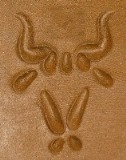
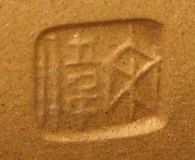 Song Wei etches a trademark "bull" logo onto each piece.
Song Wei etches a trademark "bull" logo onto each piece.In addition, he stamps each piece with another trademark consisting of his name written in stylized old Chinese characters. In keeping with ancient Chinese custom, where script was written from left to right, this stamp shows his name with the Wei character on the left and Song character on the right.










